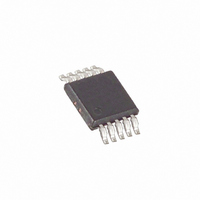MAX5040EUB+ Maxim Integrated Products, MAX5040EUB+ Datasheet - Page 14

MAX5040EUB+
Manufacturer Part Number
MAX5040EUB+
Description
IC CNTRLR VOLT TRACK 10-UMAX
Manufacturer
Maxim Integrated Products
Datasheet
1.MAX5040EUB.pdf
(21 pages)
Specifications of MAX5040EUB+
Applications
Processor
Current - Supply
1.3mA
Voltage - Supply
2.5 V ~ 5.5 V
Operating Temperature
-40°C ~ 85°C
Mounting Type
Surface Mount
Package / Case
10-MSOP, Micro10™, 10-uMAX, 10-uSOP
Lead Free Status / RoHS Status
Lead free / RoHS Compliant
of the maximum output current rating of the CORE or
I/O power supplies is adequate. However, care should
be taken when selecting this MOSFET to make sure it is
capable of sustaining all of the worst-case conditions,
as well as riding through all of the fault conditions. The
following are guidelines for selecting the external N-
channel MOSFET:
1)
2)
3)
4)
5)
6)
Voltage-Tracking Controllers for
PowerPC, DSPs, and ASICs
14
MOSFET drain-to-source maximum voltage rating:
V
MOSFET gate-to-source maximum voltage rating:
V
MOSFET gate turn-on threshold voltage: V
minimum operating voltage of (V
example, if V
CORE voltage is 1.8V, then V
2.7V. A MOSFET with logic-level gate turn-on
threshold voltage is appropriate for this application.
Determine the maximum current that can go
through the MOSFET during power-up, power-
down/brownout, or output short-circuit conditions.
In most cases, this maximum current is the current
limit of the CORE or the I/O power supplies,
whichever is larger. Choose the MOSFET with
pulse current rating sufficiently higher than this cur-
rent. Note that typical MOSFET pulse current rating
is much larger than its continuous current rating.
Determine the MOSFET maximum R
under worst-case current, the voltage drop across
its drain-to-source is within the tracking limit
(approximately 400mV for most PowerPCs, ASICs,
and DSPs).
Determine the maximum single-shot power dissipa-
tion in the MOSFET during power-up, or during an
output short-circuit condition. Considering the fol-
lowing cases:
______________________________________________________________________________________
•
•
DS
GS
rating > V
rating > V
When either the I/O or CORE is shorted to
GND, NDRV is driven high to V
MOSFET on. The current through the MOSFET
is the maximum current that the supply not
shorted can produce (the CORE supply maxi-
mum current if I/O is shorted or vice versa).
Depending on which supply is shorted, take
the maximum short-circuit current that either
the I/O or CORE supplies produce. Call this
current I
pation in the MOSFET is I
During power-up, the I/O voltage comes up
first, and the CORE power supply fails to turn
on. The MOSFET is in linear regulator mode,
supporting the CORE full-load current, as
CC
PSLIM
I/O
CC
minimum operating voltage is 4.5V,
maximum voltage.
maximum.
. In this case, the power dissi-
GS(th)
PSLIM 2
CC
< (4.5V - 1.8V) =
DSON
CC
- V
x R
, turning the
CORE
DS(ON)
such that
GS(th)
). For
.
<
7)
Example: I/O = 3.3V, I/O power supply has a current
limit (I
1.8V, CORE power supply has a current limit
(I
5V + 0.5V. CORE and I/O voltages must track to within
400mV.
Choose a Si9428DY (N-channel MOSFET, V
20V, R
at +125°C = 1.5 x R
data sheet, V
CORE(LIM)
Next, select the MOSFET that can take this single
pulse energy without going over its maximum junc-
tion temperature rating. The maximum MOSFET
junction temperature can be calculated as follows:
•
The worst-case single-shot power dissipation in
the MOSFET is the maximum value from the steps
above and for a maximum duration of t
where T
ambient temperature, P
power dissipation calculated in step 6 above, and
Z
of the selected MOSFET for a single pulse of
t
MOSFET data sheets.
FAULT
I/O(LIM
θJA
DS(ON)
well as the charging of the CORE output
capacitor. For most practical cases, the
power charging the CORE output capacitor
can be ignored. The power dissipation in the
MOSFET for this case is (V
I
age, V
and I
During power-up, the CORE voltage comes
up first, and the I/O power supply fails to turn
on. The MOSFET turns on hard, keeping the
I/O voltage close to the CORE voltage. The
MOSFET in this case supports the I/O load
current, as well as the charging of the I/O
output capacitor. For most practical cases,
the power charging the I/O output capacitor
can be ignored. Since the I/O voltage never
reaches its final value, the I/O load current
might be off and the power dissipation in the
MOSFET is minimal. However, assuming the
worst-case condition that the I/O load draws
its full-load current, the power dissipation in
the MOSFET would be I
I
is the junction-to-ambient thermal impedance
CORE
I/O
) of 6A, CORE full-load current is 4A. V
)) of 6A, I/O full-load current is 3A. CORE is
duration. Z
GS
J
is the I/O full-load current.
at +25°C = 0.04Ω at V
CORE
is the junction temperature, T
, where V
T
max = 8V).
CORE
J
= T
DS(ON)
is the CORE full-load current.
AMB
is the regulated CORE voltage,
θJA
I/O
+ P
at 25°C, from the MOSFET
is specified in all typical
is the regulated I/O volt-
PULSE
PULSE
I/O
GS
2
is the single-shot
x Z
x R
= 2.5V, R
I/O
θJA
DS(ON)
FAULT
- V
AMB
DS
CORE
, where
DS(ON)
max =
.
is the
CC
) x
=











